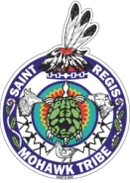Trustees for the St. Lawrence River case have released their Final Restoration Plan and Environmental Assessment (RP/EA) (PDF, 71 pages) for implementing three public access projects on tributaries to the St. Lawrence River in upstate New York. The projects will in-part benefit the Saint Regis Mohawk Tribe by restoring access to recreational fishing opportunities.
The St. Lawrence Environment Natural Resource Damage Assessment and Restoration case centers on the release of contaminants from three industrial facilities to the St. Lawrence River and its tributaries, in the Town of Massena and within the Akwesasne Tribal lands. The St. Lawrence Environment Trustee Council (SLETC) is composed of the Saint Regis Mohawk Tribe (SRMT)– the lead administrative Trustee for the case–and Co-Trustees including the New York State Department of Environmental Conservation, National Oceanic and Atmospheric Administration (NOAA), and the U.S. Fish and Wildlife Service. The SLETC is responsible for planning and implementing restoration of natural resources injured by the contamination and loss of public uses in the St. Lawrence River watershed.
In 2013, the SLETC released its Restoration and Compensation Determination Plan, identifying resources injured and public uses affected by the contamination. Contaminants including polychlorinated biphenyls, polycyclic aromatic hydrocarbons, fluoride, and metals were released from three industrial facilities beginning in 1981, and have been transported throughout the environment, causing injuries to natural resources such as river fishes, freshwater mussels, birds and wildlife, and freshwater wetlands. Public uses, such as boating, subsistence fishing, and foraging of natural resources by the SRMT were also negatively affected.
The SLETC will advance three public access projects along the St. Regis and Raquette Rivers, large tributaries that flow into the St. Lawrence River. The Akwesasne Water Access Projects will partially compensate the public for ecological and recreational fishing losses resulting from the contamination by restoring streambank habitat and public access to these rivers. The projects will also provide economic, cultural, educational, and recreational benefits to Akwesasne Tribal lands and the regional community. These Water Access Projects include:
· Skén:nen Park West Project: a riverfront park with river and fishing access located along the St. Regis River in Akwesasne, just west of the former Hogansburg dam
· Skén:nen Park East Project: public access to the St. Regis River, a nearshore fishing structure and viewing platform, cultural and environmental educational exhibits, and parking
· Raquette River Public Access Project: a public boat launch with floating docks, nearshore fishing structures and parking. This project will be the first public boat launch in Akwesasne to provide river access for recreational fishing, tribal cultural practices, and other water recreation. The project will also provide much needed local access for First Responders.
Additional project features include streambank stabilization, native vegetation plantings, installation of river platforms for wildlife viewing and recreational fishing, all-person pedestrian walkways and trails, a small boat launch, parking, informational/educational signage and kiosks, and stormwater management
and erosion control features. The next steps for these projects include design, permitting, and construction activities, which are scheduled for later in 2024 and 2025.
Restoring Benefits for Tribal Use
Akwesashró:non have faced varied environmental harms, leading to disruptions in traditional Mohawk practices and a rapid shift toward interacting with each other and their environment in non-indigenous ways. The Mohawk perspective on redress for these harms centers on promoting:
· The restoration of natural resource‐based cultural activities that were adversely affected by the release of hazardous contaminants
· The enhancement of connections between Mohawk people and the natural environment
· Knowledge transfers between generations of Mohawks, so that existing Indigenous knowledge can be preserved and enlivened

